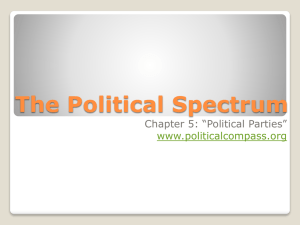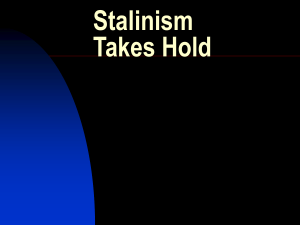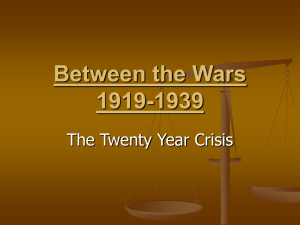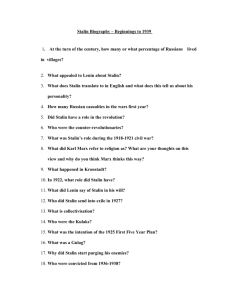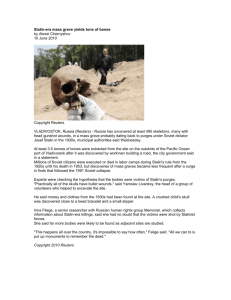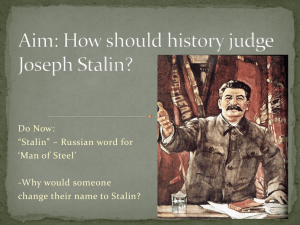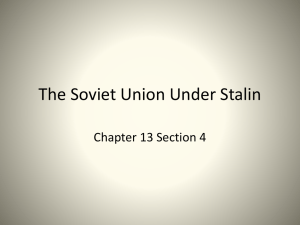Achievements under Stalin - long essay.doc
advertisement
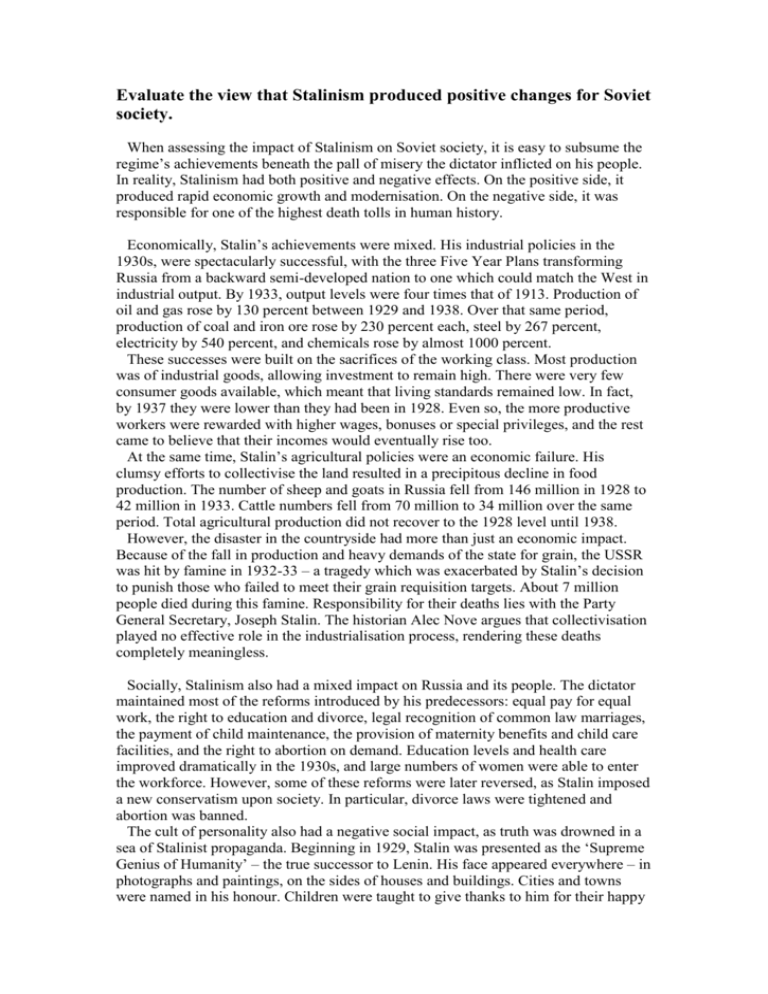
Evaluate the view that Stalinism produced positive changes for Soviet society. When assessing the impact of Stalinism on Soviet society, it is easy to subsume the regime’s achievements beneath the pall of misery the dictator inflicted on his people. In reality, Stalinism had both positive and negative effects. On the positive side, it produced rapid economic growth and modernisation. On the negative side, it was responsible for one of the highest death tolls in human history. Economically, Stalin’s achievements were mixed. His industrial policies in the 1930s, were spectacularly successful, with the three Five Year Plans transforming Russia from a backward semi-developed nation to one which could match the West in industrial output. By 1933, output levels were four times that of 1913. Production of oil and gas rose by 130 percent between 1929 and 1938. Over that same period, production of coal and iron ore rose by 230 percent each, steel by 267 percent, electricity by 540 percent, and chemicals rose by almost 1000 percent. These successes were built on the sacrifices of the working class. Most production was of industrial goods, allowing investment to remain high. There were very few consumer goods available, which meant that living standards remained low. In fact, by 1937 they were lower than they had been in 1928. Even so, the more productive workers were rewarded with higher wages, bonuses or special privileges, and the rest came to believe that their incomes would eventually rise too. At the same time, Stalin’s agricultural policies were an economic failure. His clumsy efforts to collectivise the land resulted in a precipitous decline in food production. The number of sheep and goats in Russia fell from 146 million in 1928 to 42 million in 1933. Cattle numbers fell from 70 million to 34 million over the same period. Total agricultural production did not recover to the 1928 level until 1938. However, the disaster in the countryside had more than just an economic impact. Because of the fall in production and heavy demands of the state for grain, the USSR was hit by famine in 1932-33 – a tragedy which was exacerbated by Stalin’s decision to punish those who failed to meet their grain requisition targets. About 7 million people died during this famine. Responsibility for their deaths lies with the Party General Secretary, Joseph Stalin. The historian Alec Nove argues that collectivisation played no effective role in the industrialisation process, rendering these deaths completely meaningless. Socially, Stalinism also had a mixed impact on Russia and its people. The dictator maintained most of the reforms introduced by his predecessors: equal pay for equal work, the right to education and divorce, legal recognition of common law marriages, the payment of child maintenance, the provision of maternity benefits and child care facilities, and the right to abortion on demand. Education levels and health care improved dramatically in the 1930s, and large numbers of women were able to enter the workforce. However, some of these reforms were later reversed, as Stalin imposed a new conservatism upon society. In particular, divorce laws were tightened and abortion was banned. The cult of personality also had a negative social impact, as truth was drowned in a sea of Stalinist propaganda. Beginning in 1929, Stalin was presented as the ‘Supreme Genius of Humanity’ – the true successor to Lenin. His face appeared everywhere – in photographs and paintings, on the sides of houses and buildings. Cities and towns were named in his honour. Children were taught to give thanks to him for their happy lives. Stalin also arranged for history to be rewritten, to emphasise his own role the Revolution and the Civil War. All this had a stultifying effect on society. Politically, the impact of Stalinism on society was universally negative. Stalin gradually dismantled Lenin’s system of collective leadership, centralising all power in his own hands. He then proceeded to purge all those who might present a threat to his rule. Managers, doctors, scientists, artists, workers – all were subjected to the dead hand of the secret police. In human terms, the cost was staggering. Robert Conquest estimates the number killed to have been 18 million between 1930 and ’39. The impact of the Terror was that fear permeated every level of society and trust all but disappeared. People were left with little choice but to accept Stalin’s claims that a giant conspiracy was taking place against himself and the Revolution – particularly since so many senior Communists were confessing to this. Hence, it must be concluded that the impact of Stalinism on Soviet society was mixed. While he did oversee the industrial development of the country, allowing it to resist the Nazi onslaught in 1941, he also subjected his people to a regime of lies, fear and dictatorship, which resulted in over 20 million deaths.

